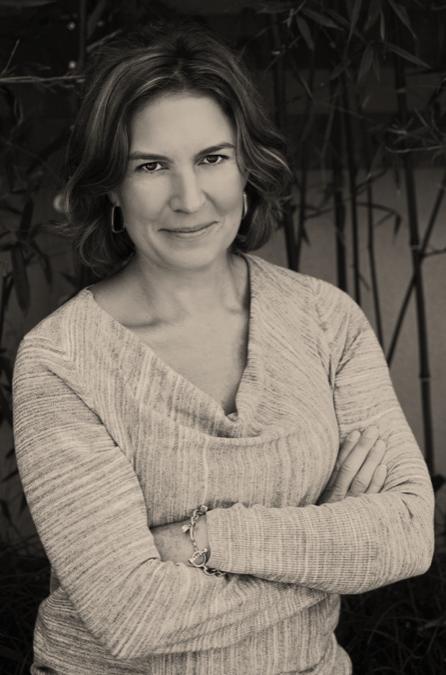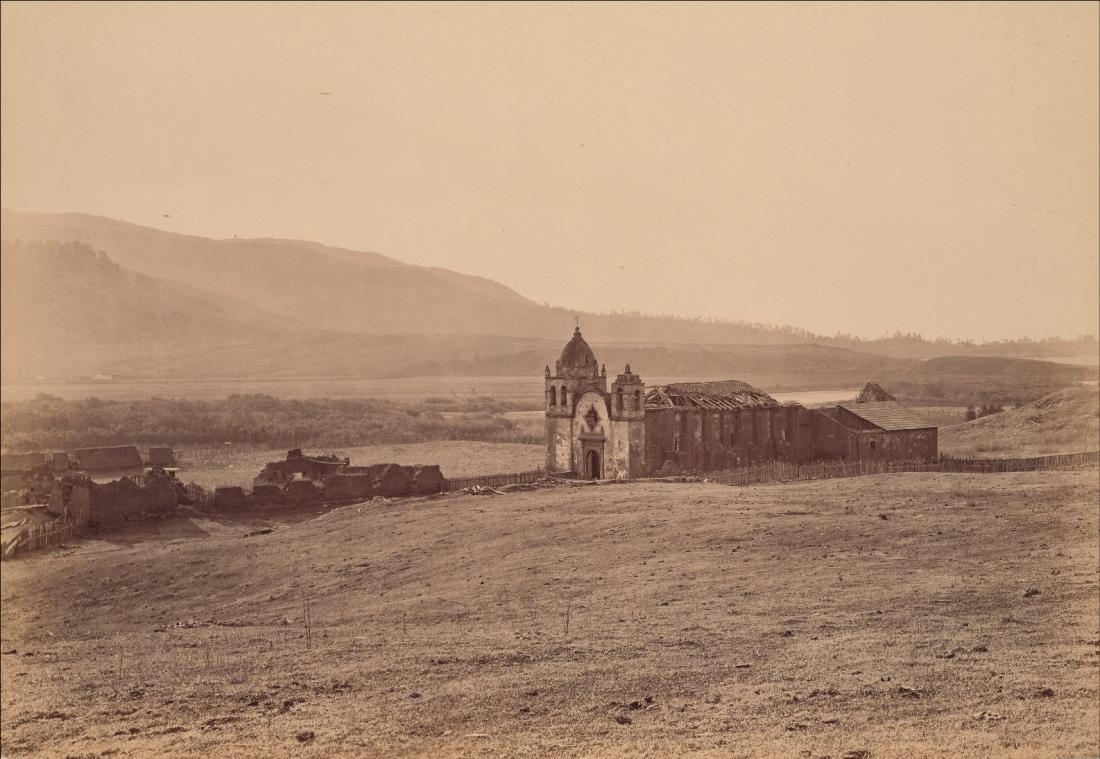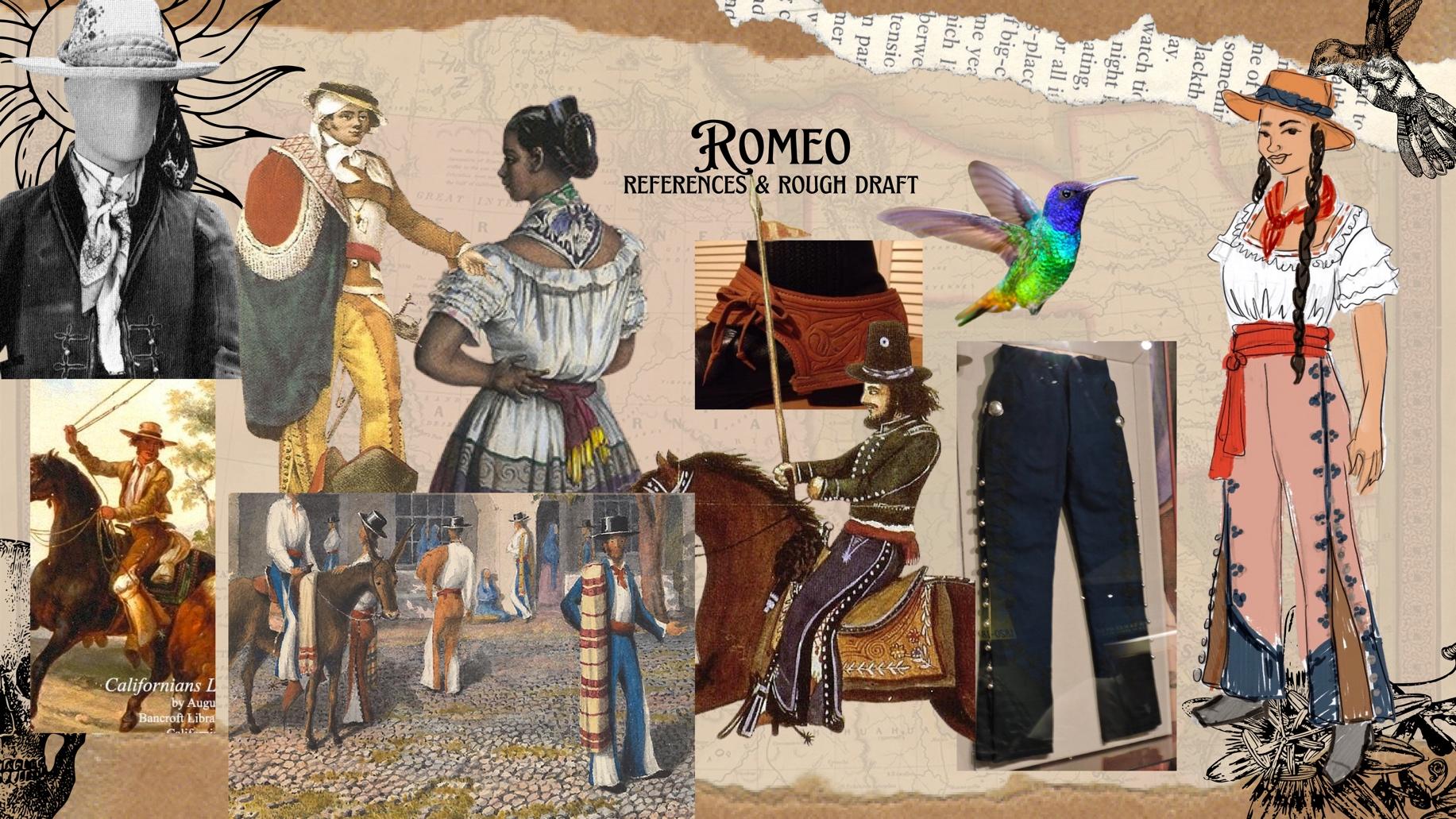



RESOURCE GUIDE

BIENVENIDOS!
Welcome to the Resource Guide for Romeo y Juliet. In the following pages, you’ll find information about the play and its historical context, as well as activities and discussion questions to facilitate your students’ exploration of the world of this play. These materials are intended for middle and high school classrooms and include a list of relevant TEKS. Feel free to adapt any of the activities to your students’ needs. We hope you enjoy the show!
TABLE OF CONTENTS
1 . . . About the Play 2 . . . The Story 3 . . . The Players 4 . . . Alta California 6 . . . Discussion Questions 7 . . . Activity: Translating 8 . . . Scenic Design 9 . . . Projection Design 10 . . . Lighting Design 11 . . . Costume Design 12 . . . TEKS 13 . . . Team & Special Thanks This
was compiled, devised, & edited by Demian Chavez Galvan
resource guide
ABOUT THE PLAY
Romeo y Juliet tells Shakespeare’s tale of star -crossed lovers, daughters of the feuding houses of Montague and Capulet, reimagined in Alta California in 1848, shortly after the end of the Mexican- American War and prior to the annexation of California. Set in the limbo between Mexican rule and statehood, this retelling shifts between English and Spanish, bringing new life to a story of love, bloodshed, family, and fate.
THE PLAYWRIGHTS



Karen Zacarias (Playwright) is hailed by American Theatre Magazine as one of the most produced playwrights in the United States. She has four Broadwaybound musicals, including Destiny of Desire and Five Notes, with music by Gloria Estefan. Her plays include Native Gardens, The Age of Innocence, Legacy of Light, Mariela in the Desert, The Sins of Sor Juana, and adaptations of Into the Beautiful North and How the Garcia Girls Lost Their Accent. She is the author of ten renowned Theatre for Young Audiences musicals and the librettist of several ballets. She is one of inaugural resident playwrights at Arena Stage in Washington D.C.; a core founder of the Latinx Theatre Commons, which seeks to update the American narrative with stories of Latinos; and founder of the award-winning Young Playwrights’ Theater.
KJ Sanchez (Co-Conceiver & Script Collaborator) is the area head of the M.F.A. in Theatre, Playwriting/Directing programs at the University of Texas at Austin. She is also the founder and CEO of American Records, dedicated to making theatre that chronicles our time. Sanchez recently directed Jose Cruz Gonzalez’s American Mariachi at the Alley Theatre in Houston, Texas. As a director, Sanchez has worked with playwrights such as Octavio Solis, Karen Zacarias, Quiara Alegria Hudes, Martin Zimmerman, and Kristoffer Diaz. Her productions have been seen at The Guthrie Theatre, Huntington Theatre Company, The Alley Theatre, Arizona Theatre Company, Berkeley Repertory Theatre, Baltimore Center Stage, Cincinnati Playhouse, Playmakers Repertory Company, Actors Theatre of Louisville, and Frontera Repertory.



THE STORY
ACT I
The feud between the Montagues and Capulets erupts into a brawl on the streets of Verona, until the General intervenes and threatens punishment if violence persists. Capulet hopes to marry his daughter Juliet to Paris and invites him to a party at his house. Montague’s daughter Romeo is in love with a girl who doesn’t love her. Romeo’s cousin, Benvolio, and friend, Mercutio, convince Romeo to come to Capulet’s party, where he falls in love with Juliet at first sight.
ACT II
After the party, Romeo stays near the Capulet house and finds Juliet at her balcony. They declare their love for another and their intent to marry. The next morning, Romeo goes to Friar Lawrence, her friend and mentor, to ask him to marry them. Hopeful that the marriage can at last end the Montague-Capulet feud, the Friar agrees. Juliet’s Nurse helps arrange the secret wedding.
ACT III
Juliet’s cousin Tybalt looks for Romeo, after noticing her at the party and taking offense. Romeo, just married, refuses to fight Tybalt, who is now family. An angry Mercutio fights Tybalt and is killed when Romeo steps between them. Romeo kills Tybalt and flees. The General, learning of the deaths, banishes Romeo from Verona. Friar Lawrence arranges for Romeo’s escape to Monterey. The Capulets grieve Tybalt, while Juliet grieves Romeo’s banishment.
ACT IV
Juliet, not wanting to marry Paris, goes to Friar Lawrence, who gives her a potion that will make her seem dead. He sends a letter to Romeo informing her of their plan.
ACT V
The friar’s letter doesn’t reach Romeo. Instead, believing Juliet is dead, Romeo buys poison and returns to Verona. At Juliet’s tomb, Romeo fights and kills Paris before drinking the poison. Juliet awakes to the sight of her lover dead. She uses Romeo’s dagger to end her own life.
THE PLAYERS
KJ Sanchez & Karen Zacarias’ adaptation of Romeo y Juliet sets the action in Alta California in 1848. In this version, the Montagues are ranchers of mixed Spanish and indigenous descent, while the Capulets are proud Mexicans who are eager to assimilate when Alta California falls under U.S. control. Shakespeare’s Prince of Verona becomes a General in the U.S. Cavalry, signifying American presence in Alta California.
ROMEO . . . A cowgirl who runs the Montague ranch
JULIET . . . The sheltered daughter of Capulet
BENVOLIO . . . Romeo’s cousin, friend, and confidant
TYBALT . . . Juliet’s cousin, a fierce fighter
MERCUTIO . . . Romeo’s friend, related to the General
FR. LAWRENCE A friend and mentor to Romeo
NURSE
CAPULET .

Juliet’s devoted and loving caretaker
. The patriarch of the Capulet family
LADY CAPULET . . . Capulet’s American “prize bride”
PARIS . . . U.S. Army Captain, related to General
GENERAL . . . De facto governor of Verona
SERVANT . . . A servant of the Capulet household
BALTHAZAR . . . A servant of the Montague household
APOTHECARY . . . A seller of drugs, potions, and herbs
FR. JOHN . . . Another friar in Lawrence’s order
. . .
.

HISTORY OF ALTA CALIFORNIA
When Sanchez and Zacarias first set out to write a bilingual adaptation of Shakespeare’s tragedy, they knew they needed to place the action in a setting that felt like a pressure cooker. Five people will die by the time the play is over, and we need to understand the tragic consequences that come crashing down around them.
They found their setting in Alta California, a province of New Spain annexed by the United States following the Mexican–American War. The land now known as California has been inhabited by hundreds of indigenous groups for thousands of years; prior to the Colonization of the Americas, California was home to nearly one third of the indigenous population of the land that would become the United States. Long-term Spanish occupation of California began in 1769, when Gaspar de Portolá, Governor of Las Californias, led an expedition along the Californian coast that asserted Spanish control over the region.
Between 1769 and 1833, Franciscan missionaries established 21 missions along the coast of Alta California. These missions served as the foundation of Spanish settlement and expansion into California, as well as the center of efforts to convert and assimilate the native peoples of California. Indigenous rebellions and raids on missions were common during the late 18th century. Around this time, ranchos (plots for cattle grazing) began to sprout up across the province, fundamentally transforming California’s landscape and environment.
The Viceroyalty of New Spain, of which Alta California was a part of, began its War for Independence in 1810. The Treaty of Cordoba, signed in 1821, granted its independence. The 1824 Constitution of Mexico established a republic which further promoted cattle ranching in Alta California, while pushing to secularize the region. The Mexican Secularization Act of 1833 ended religious authority over California’s native peoples and seized land from the missions, much of which would be sold or given as a land grant for ranchos.
Amidst widespread uprisings in Mexico under the rule of Antonio Lopez de Santa Anna, the Texas Revolution began, as American settlers and Hispanic Tejanos fought for independence from Mexico. Texas won her independence in 1836, establishing the Republic of Texas, and later joining the United States in 1846. The annexation of Texas triggered territorial disputes between the United States and Mexico, which would lead to the Mexican- American War breaking out in 1846. The Treaty of Guadalupe Hidalgo, signed in 1848, ended the War and forced Mexico to cede over half of their territory to the United States. On February 2, 1848, Alta California, part of the ceded land, became a possession of the United States of America.

CULTURE OF ALTA CALIFORNIA
By the 1840s, Hispanic Californians had come to develop a distinct regional identity. They were Californios, the land-owning descendants of settlers whose ranchos dominated Alta Californian society and industry. These settlers were first Spanish and Mexican, but increasingly, European and American settlers migrated to the area, learned Spanish, converted to Catholicism, and married into a Californio family, becoming a Californio.
The dominance of cattle ranching, assimilation of indigenous peoples, distance from the center of governance, and the influence of Franciscans gave rise to the unique culture and customs of the Californios. From the time that Alta California was first settled by Spaniards, Catholic missions and cattle ranching dominated the region and culture. Missions formed the backbone of Spanish expansion and control throughout California and were instrumental in assimilating native people, while cattle ranching heavily informed the economic and cultural background of the region. After the Mexican Secularization Act of 1833, the prominence of ranchos and cattle ranching grew as the Catholic Church was stripped of its inf luence and land, much of which went into the hands of Californios in the form of land grants. Few indigenous Californians were returned or granted land, and many went on to form the workforce that labored in Californio ranchos.
Californio society revolved around three key things – patriarchs, parties, and ponies. Alta California was staunchly patriarchal, though women were valued and had a place in politics and business. Nonetheless, women weren’t generally allowed to own land, and it was expected that patriarchs exercise control over their family. Californio ranchos were the gathering ground for frequent fiestas, fandangos, rodeos, and roundups to celebrate everything from weddings to christenings, and even to mourn the dead. Californios often traveled the rancho party circuit on horseback. Horses, then a plentiful animal in the region, were a primary mode of transportation for Californios and had become deeply engrained in the local culture and economy.

 The Mission of San Carlos del Carmelo. Photograph by Carleton Watkins, c. 1880.
The Mission of San Carlos del Carmelo. Photograph by Carleton Watkins, c. 1880.

DISCUSSION QUESTIONS
BEFORE THE SHOW
Have students discuss the following questions together prior to attending the show. It’s okay if these questions lead to questions of their own!
1. What’s your experience with the works of William Shakespeare?
Have you read his plays before, performed in them, or seen them?
2. This version of Romeo y Juliet is set in Alta California in 1848.
How do you think the setting will impact how the story plays out?
3. Do you believe in love at first sight?
AFTER THE SHOW
Have students discuss the following questions together after attending the show. It’s okay if these questions lead to questions of their own!
1. At what point does the play become a tragedy? Who is at fault?
Discuss how the circumstances and choices of the characters affect the story
2. Were Romeo and Juliet really in love? Their story starts and ends in three days.
Discuss and draw on evidence and examples from the play.
3. Was Romeo and Juliet’s love doomed or was their fate avoidable?
Discuss how the historical and character context affects the fate of the lovers.
ACTIVIT Y: TRANSLATING SHAKESPEARE
Below is an excerpt from Act II Scene II of Romeo y Juliet, the famous balcony scene. There is the original Shakespeare, KJ Sanchez and Karen Zacarias’ version, and a version in modern English. Share the original and bilingual versions with your students, and task them with creating their own version of the excerpt in modern English. Afterwards, they may compare with the provided modern English translation.
ORIGINAL SHAKESPEARE
But soft! What light through yonder window breaks?
It is the East, and Juliet is the sun!
Arise, fair sun, and kill the envious moon,
Who is already sick and pale with grief
That thou her maid art far more fair than she.
Be not her maid, since she is envious.
Her vestal livery is but sick and green,
And none but fools do wear it. Cast it off.
It is my lady; O, it is my love!
O that she knew she were!
She speaks, yet she says nothing. What of that?
Her eye discourses; I will answer it.
I am too bold; 'tis not to me she speaks.
MODERN ENGLISH

KAREN & KJ’s VERSION
But, soft! What light through yonder window breaks?
It is the east, and Juliet is the sun, el sol entero. Arise, fair sun, and kill the envious moon,
Who is already sick and pale with grief,
That thou her maid art far more fair than she:
No sirvas a la luna, que te envidia.
Su manto de vestir está verde, triste y descolorido –y ninguna doncella lo porta. ¡Arrójala!
It is my lady, O, es mi amor.
O, that she knew she were!
She speaks yet she says nothing: what of that?
Her eye discourses; I will answer it.
I am too bold, ‘tis not to me she speaks:
But wait, what's that light in the window over there? It is the east, and Juliet is the sun. Rise up, beautiful sun, and kill the jealous moon. The moon is already sick and pale with grief because you, Juliet, her maid, are more beautiful than she. Don't be her maid, because she is jealous. Virginity makes her look sick and green. Only fools hold on to their virginity. Let it go. Oh, there's my lady! Oh, it is my love. Oh, I wish she knew how much I love her. She's talking, but she's not saying anything. So what? Her eyes are saying something. I will answer them. I am too bold. She's not talking to me.

SCENIC DESIGN
The distinctive architecture of Alta California ranchos and haciendas inspires the work of Alex Rockey (Scenic Designer), Joshua W. Martin, and Natalia Martin Rodezo (Asst. Scenic Designers). Their scenic design helps us understand the rancho as the social center of Californio life and sets the scene for the tragic events that unfold.
Collaboration with Heekyung Kim (Projection Designer) helps transform the set to a plaza in Verona, a friar’s cell in a mission, a Californio saloon, an orchard, and finally, the tomb where our star -crossed lovers meet their untimely end. Collaboration between scenic design and projection design also gives us El Sol / La Luna, a moving sun and moon that frames outside scenes. Lastly, wrought iron lamps hung overhead and a moving chandelier help completely immerse us in the world of Alta California in 1848.

 A rendering of Alex Rockey’s set for Romeo y Juliet in the Oscar G. Brocket Theatre. Renderings such as this give the director and the cast a clear image of the set throughout the rehearsal process, as the set is being built.
A rendering of Alex Rockey’s set for Romeo y Juliet in the Oscar G. Brocket Theatre. Renderings such as this give the director and the cast a clear image of the set throughout the rehearsal process, as the set is being built.

PROJECTION DESIGN
This Romeo y Juliet is a memory play remembered and narrated by Benvolio, the sole young person who survives the violence that transpires throughout the play. The rich, intricate, and evocative projections by Heekyung Kim (Projection Designer), AJ Hurtado (Projection Technician), and Arash Baghipour (Asst. Projection Designer) move us seamlessly between vibrant love, and desolate memories. Programs such as Unreal Engine are used to create the intricate pictures you’ll see. Kim’s images are often projected onto Alex Rockey’s set, which calls for close and clever collaboration. Kim uses a system called Disguise to carefully manage multiple projectors and meticulously plots out her work on the set. This process, known as mapping, is used to turn the irregularly -shaped set into a finely -tuned surface for seamless projections.


A behind-the-scenes looking at projection mapping, the process of turning irregular objects into projection surfaces. Heekyung has color -coded different areas of the set to create different “ zones ” to project her images onto

LIGHTING DESIGN
Serene moonlit nights, joyous torch-lit parties, and cathedrals bathed in the light of stained-glass windows are some of the sights crafted by Gavin Strawnato (Lighting Designer) and Jacob Zamarripa (Asst. Lighting Designer) for Romeo y Juliet. Strawnato’s design is inspired by Latine culture; the murals of Diego Rivera and Jose Clemente Orozco, the vibrant paintings of Patssi Valdez, and the sun-scorched photography of Bruno Barbey inform the approach to lighting this story. In particular, Strawnato draws from the work of Joaquín Torres-Garcia, a Uruguayan-Spanish artist whose abstract works, with their thick and uneven grids, resemble the patchy stainedglass windows of the Metropolitan Cathedral. Strawnato’s design honors these artists.

 Joaquin Torres-Garcia, Construction in White and Black, 1938
Joaquin Torres-Garcia, Construction in White and Black, 1938
COSTUME DESIGN
The distinctive dress of Californios, vaqueros, and U.S. Cavalry is beautifully recreated by Leah Hummel (Costume Designer), Rachel Green (Assoc. Designer), Layla Crear, and Olivia Saldaña (Asst. Designers). Their design is a careful combination of script analysis and anthropology, seeking to convey the external context of Alta California.
The central conflict of the play is between the Montagues, a Californio vaquero family of Spanish and Indigenous descent, and the Capulets, proud Mexicans who are eager to assimilate into the newly dominant American culture. The Montagues are visibly ranchers, clad in side-fastened calzoneras, leather botas, and shoulder -swept serapes –the practical attire of horse-riders. The Capulets retain vestiges of their Mexican heritage in their clothing but are heavily influenced by American Victorian-era silhouettes.



References & Rough Draft of Romeo’s Costume by Leah Hummel
TEKS

Theatre TEKS
§117.315. Theatre, Level I
4 D. Appreciate the cultural heritages of world drama and theatre and identify key figures, works, and trends in dramatic literature;
4 E. Appreciate the multicultural heritage of United States drama and theatre and identify key figures, works, and trends in dramatic literature;
§117.316. Theatre, Level II
5 A. Evaluate and apply appropriate audience etiquette at various types of performances
History TEKS
§113.42 World History
25 A. Analyze examples of how art, architecture, literature, music, and drama reflect the history of the cultures in which they are produced
25 B. Describe examples of art, music, and literature that transcend the cultures in which they were created and convey universal themes.
Languages other than English TEKS (Spanish)
§114.39 Level I
2 B. Identify key words & details from fiction & nonfiction texts & audio and audiovisual materials;
2 C. Infer meaning of unfamiliar words or phrases in highly contextualized texts, audio, and audiovisual materials;
§113.20 Social Studies, Grade 8
6 B. Analyze the westward growth of the nation, including the Louisiana Purchase & Manifest Destiny;
6 C. Explain the causes & effects of the U.S.-Mexican War & their impact on the United States.
23 B. Explain how urbanization contributed to conflicts resulting from differences in religion, social class, and political beliefs;
CAST
Benvolio . . . Yobany Pizano
Tybalt . . . Brandt Agosto-Medina
Capulet . . . Victor Santos
Lady Capulet . . . Kira Small
General . . . Michael Okooti
Romeo .
Paris .
Servant
Nurse
Juliet
Mercutio

. Valeria Najera
†Dominic Gross
Rosy Esquenazi Alkabes
Esmeralda Treviño
Karla Bermudez
Emilio Mejia
Friar Lawrence .
Balthazar . . .
Apothecary . . .
Jorge Gonzales
*Valeria Guajardo
**Celeste Izaguirre
Friar John . . . Andre Lira
Musician . . . Milo Darlington
† Fight Captain
* Romeo Understudy
** Juliet Understudy
CREATIVES
Director . . . Anna Skidis-Vargas
Asst. Director . . . Rodolfo Robles Cruz
Stage Manager
. Leila Rabah
Asst. Stage Manager
Technical Director .
. . Laura Soares
. David Tolin
Intimacy Director . . . Andy Grapko
Fight Director . . . Justin Gordon
Scenic Design . . . Alex Rockey
Asst. Scenic . . . Joshua W. Martin
Asst. Scenic . . . Natalia Martin Rodezno
Projection Design
Asst. Projection
Lighting Design
Asst. Lighting
Costume Design
Assoc. Costume
. Heekyung Kim
. Arash Baqipur
Gavin Strawnato
Jacob Zamarripa
Leah Hummel
. Rachel Green
Asst. Costume . . . Layla Crear
Asst. Costume . . . Olivia Saldaña
Music . . . Demian Chavez Galvan
Sound Design . . . Olivia Longoria
SPECIAL THANKS TO
Madge Darlington, Karen Zacarias, KJ Sanchez, Ken Cerniglia, Dana McLaughlin, Sydney Pattillo, Tony & Maria Chavez, & Samantha Brown
.
. .
. . .
. .
.
. .
.
. .
.
.
.
. .
.
.
. .
. .
. . .
. .
.
. .
.
. .













 The Mission of San Carlos del Carmelo. Photograph by Carleton Watkins, c. 1880.
The Mission of San Carlos del Carmelo. Photograph by Carleton Watkins, c. 1880.

 A rendering of Alex Rockey’s set for Romeo y Juliet in the Oscar G. Brocket Theatre. Renderings such as this give the director and the cast a clear image of the set throughout the rehearsal process, as the set is being built.
A rendering of Alex Rockey’s set for Romeo y Juliet in the Oscar G. Brocket Theatre. Renderings such as this give the director and the cast a clear image of the set throughout the rehearsal process, as the set is being built.



 Joaquin Torres-Garcia, Construction in White and Black, 1938
Joaquin Torres-Garcia, Construction in White and Black, 1938

